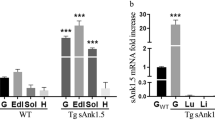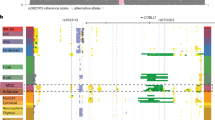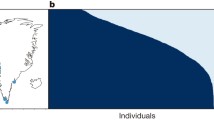Abstract
Calgranulin B (S100A9) was recognized as a candidate type 2 diabetes (T2D) gene in the genomic profiling of muscle from a rodent model of T2D and identifying the human orthologs of genes localized in T2D susceptibility regions. Circulating and S100A9 expressions in muscle and adipose tissue, isolated fat cells, and mouse models were evaluated. A common 5′-upstream single-nucleotide polymorphism (SNP; rs3014866) for S100A9 was analyzed, as well as the effects of weight loss and treatments in vitro with recombinant S100A9. S100a9 expression was increased in muscle of diabetic mice (1.6-fold, p = 0.002), and in muscle from subjects with impaired glucose tolerance (∼4-fold, p = 0.028; n = 34). The rs3014866 SNP was associated with circulating S100A9 and the risk of T2D, having TT carriers at 28 % (p = 0.03) lower risk (n = 1,450). Indeed, increased circulating S100A9 (∼4-fold, p = 0.03; n = 206) and subcutaneous (2-fold, p = 0.01) and omental (1.4-fold, p = 0.04) S100A9 gene expressions (n = 83) in TT carriers run in parallel to decreased fasting glucose and glycated hemoglobin. Accordingly, metformin led to increased S100A9 mRNA in ex vivo-treated adipose tissue explants (n = 5/treatment). Otherwise, obese subjects showed a compensatory increase in circulating and S100A9 expressions in adipose (n = 126), as further demonstrated by decreased levels after diet- (−34 %, p = 0.002; n = 20) and surgery-induced (−58 %, p = 0.02; n = 8) weight loss. Lipopolysaccharide led to increased S100A9 in adipose from mice (n = 5/treatment) while recombinant S100A9 downregulated inflammation in adipocytes (n = 3/treatment). Current findings support the strategy of testing differentially expressed genes in mice and human orthologs associated with T2D. The increased S100A9 reported for obesity and insulin resistance may be envisioned as a compensatory mechanism for inflammation.




Similar content being viewed by others
References
Devedjian JC, George M, Casellas A, Pujol A, Visa J, Pelegrin M, Gros L, Bosch F (2000) Transgenic mice overexpressing insulin-like growth factor-II in beta cells develop type 2 diabetes. J Clin Invest 105:731–740
Elbein SC, Hoffman MD, Teng K, Leppert MF, Hasstedt SJ (1999) A genome-wide search for type 2 diabetes susceptibility genes in Utah Caucasians. Diabetes 48:1175–1182
Ehrchen JM, Sunderkotter C, Foell D, Vogl T, Roth J (2009) The endogenous Toll-like receptor 4 agonist S100A8/S100A9 (calprotectin) as innate amplifier of infection, autoimmunity, and cancer. J Leukoc Biol 86:557–566
Averill MM, Barnhart S, Becker L, Li X, Heinecke JW, Leboeuf RC, Hamerman JA, Sorg C, Kerkhoff C, Bornfeldt KE (2011) S100A9 differentially modifies phenotypic states of neutrophils, macrophages, and dendritic cells: implications for atherosclerosis and adipose tissue inflammation. Circulation 123:1216–1226
Catalan V, Gomez-Ambrosi J, Rodriguez A, Ramirez B, Rotellar F, Valenti V, Silva C, Gil MJ, Fernandez-Real JM, Salvador J et al (2011) Increased levels of calprotectin in obesity are related to macrophage content: impact on inflammation and effect of weight loss. Mol Med 17:1157–1167
Ortega FJ, Sabater M, Moreno-Navarrete JM, Pueyo N, Botas P, Delgado E, Ricart W, Fruhbeck G, Fernandez-Real JM (2012) Serum and urinary concentrations of calprotectin as markers of insulin resistance and type 2 diabetes. Eur J Endocrinol 167:569–578
Fernandez-Real JM, Pickup JC (2008) Innate immunity, insulin resistance and type 2 diabetes. Trends Endocrinol Metab 19:10–16
Gubern C, Lopez-Bermejo A, Biarnes J, Vendrell J, Ricart W, Fernandez-Real JM (2006) Natural antibiotics and insulin sensitivity: the role of bactericidal/permeability-increasing protein. Diabetes 55:216–224
Lopez-Bermejo A, Chico-Julia B, Castro A, Recasens M, Esteve E, Biarnes J, Casamitjana R, Ricart W, Fernandez-Real JM (2007) Alpha defensins 1, 2, and 3: potential roles in dyslipidemia and vascular dysfunction in humans. Arterioscler Thromb Vasc Biol 27:1166–1171
Moreno-Navarrete JM, Martinez-Barricarte R, Catalan V, Sabater M, Gomez-Ambrosi J, Ortega FJ, Ricart W, Bluher M, Fruhbeck G, Rodriguez de Cordoba S et al (2010) Complement factor H is expressed in adipose tissue in association with insulin resistance. Diabetes 59:200–209
Mellbin LG, Hamsten A, Malmberg K, Steffensen R, Ryden L, Ohrvik J, Hansen TK (2010) Mannose-binding lectin genotype and phenotype in patients with type 2 diabetes and myocardial infarction: a report from the DIGAMI 2 trial. Diabetes Care 33:2451–2456
Fernandez-Real JM, Valdes S, Manco M, Chico B, Botas P, Campo A, Casamitjana R, Delgado E, Salvador J, Fruhbeck G et al (2010) Surfactant protein d, a marker of lung innate immunity, is positively associated with insulin sensitivity. Diabetes Care 33:847–853
Edgeworth J, Gorman M, Bennett R, Freemont P, Hogg N (1991) Identification of p8,14 as a highly abundant heterodimeric calcium binding protein complex of myeloid cells. J Biol Chem 266:7706–7713
Striz I, Trebichavsky I (2004) Calprotectin—a pleiotropic molecule in acute and chronic inflammation. Physiol Res 53:245–253
Ehlermann P, Eggers K, Bierhaus A, Most P, Weichenhan D, Greten J, Nawroth PP, Katus HA, Remppis A (2006) Increased proinflammatory endothelial response to S100A8/A9 after preactivation through advanced glycation end products. Cardiovasc Diabetol 5:6
Foell D, Frosch M, Sorg C, Roth J (2004) Phagocyte-specific calcium-binding S100 proteins as clinical laboratory markers of inflammation. Clin Chim Acta 344:37–51
Mortensen OH, Nielsen AR, Erikstrup C, Plomgaard P, Fischer CP, Krogh-Madsen R, Lindegaard B, Petersen AM, Taudorf S, Pedersen BK (2009) Calprotectin–a novel marker of obesity. PLoS One 4:e7419
Hsu K, Champaiboon C, Guenther BD, Sorenson BS, Khammanivong A, Ross KF, Geczy CL, Herzberg MC (2009) Anti-infective protective properties of S100 calgranulins. Antiinflamm Antiallergy Agents Med Chem 8:290–305
Perera C, McNeil HP, Geczy CL (2010) S100 calgranulins in inflammatory arthritis. Immunol Cell Biol 88:41–49
Newton RA, Hogg N (1998) The human S100 protein MRP-14 is a novel activator of the beta 2 integrin Mac-1 on neutrophils. J Immunol 160:1427–1435
Valdes S, Botas P, Delgado E, Alvarez F, Cadorniga FD (2007) Population-based incidence of type 2 diabetes in northern Spain: the Asturias Study. Diabetes Care 30:2258–2263
Moreno-Navarrete JM, Ortega FJ, Bassols J, Castro A, Ricart W, Fernandez-Real JM (2008) Association of circulating lactoferrin concentration and 2 nonsynonymous LTF gene polymorphisms with dyslipidemia in men depends on glucose-tolerance status. Clin Chem 54:301–309
Fernandez-Real JM, Mercader JM, Ortega FJ, Moreno-Navarrete JM, Lopez-Romero P, Ricart W (2010) Transferrin receptor-1 gene polymorphisms are associated with type 2 diabetes. Eur J Clin Invest 40:600–607
Bonora E, Targher G, Alberiche M, Bonadonna RC, Saggiani F, Zenere MB, Monauni T, Muggeo M (2000) Homeostasis model assessment closely mirrors the glucose clamp technique in the assessment of insulin sensitivity: studies in subjects with various degrees of glucose tolerance and insulin sensitivity. Diabetes Care 23:57–63
Moreno-Navarrete JM, Ortega FJ, Rodriguez-Hermosa JI, Sabater M, Pardo G, Ricart W, Fernandez-Real JM (2011) OCT1 Expression in adipocytes could contribute to increased metformin action in obese subjects. Diabetes 60:168–176
Cani PD, Knauf C, Iglesias MA, Drucker DJ, Delzenne NM, Burcelin R (2006) Improvement of glucose tolerance and hepatic insulin sensitivity by oligofructose requires a functional glucagon-like peptide 1 receptor. Diabetes 55:1484–1490
Gauderman WJ (2002) Sample size requirements for association studies of gene-gene interaction. Am J Epidemiol 155:478–484
Leclerc E, Fritz G, Vetter SW, Heizmann CW (2009) Binding of S100 proteins to RAGE: an update. Biochim Biophys Acta 1793:993–1007
Fischer M, Timper K, Radimerski T, Dembinski K, Frey DM, Zulewski H, Keller U, Muller B, Christ-Crain M, Grisouard J (2010) Metformin induces glucose uptake in human preadipocyte-derived adipocytes from various fat depots. Diabetes Obes Metab 12:356–359
Alexandre KB, Smit AM, Gray IP, Crowther NJ (2008) Metformin inhibits intracellular lipid accumulation in the murine pre-adipocyte cell line, 3T3-L1. Diabetes Obes Metab 10:688–690
Yang RZ, Lee MJ, Hu H, Pray J, Wu HB, Hansen BC, Shuldiner AR, Fried SK, McLenithan JC, Gong DW (2006) Identification of omentin as a novel depot-specific adipokine in human adipose tissue: possible role in modulating insulin action. Am J Physiol Endocrinol Metab 290:E1253–E1261
Marenholz I, Heizmann CW, Fritz G (2004) S100 proteins in mouse and man: from evolution to function and pathology (including an update of the nomenclature). Biochem Biophys Res Commun 322:1111–1122
Herder C, Zierer A, Koenig W, Roden M, Meisinger C, Thorand B (2009) Transforming growth factor-beta1 and incident type 2 diabetes: results from the MONICA/KORA case-cohort study, 1984–2002. Diabetes Care 32:1921–1923
Lim SY, Raftery MJ, Goyette J, Hsu K, Geczy CL (2009) Oxidative modifications of S100 proteins: functional regulation by redox. J Leukoc Biol 86:577–587
Acknowledgments
We greatly appreciate the technical assistance of Gerard Pardo and Oscar Rovira (Unit of Diabetes, Endocrinology and Nutrition, Institut d’Investigació Biomèdica de Girona (IdIBGi) and Hospital Universitari Dr. Josep Trueta de Girona). The work of all the members of the Multidisciplinary Obesity Team of the Clínica Universitaria de Navarra is gratefully acknowledged. GenDiab Consortium was constituted with funds from the Ministerio de Educación y Ciencia (grant GEN2001-4758). This work was also supported by research grants from the Ministerio de Educación y Ciencia (SAF2005-02073 and SAF2008-02073), Generalitat de Catalunya 265, and the Instituto de Salud Carlos III (ISCIIIRETIC RD06, REDIMET, and CIBERDEM). JMM was supported by Sara Borrell fellowship from the Instituto de Salud Carlos III. RB is a recipient of a funding from the Agence Nationale de la Recherche (Florinflam and Floradip programs) as well as from L’Institute Nationale du Diabète. JMF-R is the guarantor of this work, had full access to all the data, and takes full responsibility for the integrity of data and the accuracy of data analysis.
Disclosure
The authors have nothing to disclose.
Author information
Authors and Affiliations
Corresponding author
Electronic supplementary material
Below is the link to the electronic supplementary material.
ESM 1
(PDF 464 kb)
Rights and permissions
About this article
Cite this article
Ortega, F.J., Mercader, J.M., Moreno-Navarrete, J.M. et al. Targeting the association of calgranulin B (S100A9) with insulin resistance and type 2 diabetes. J Mol Med 91, 523–534 (2013). https://doi.org/10.1007/s00109-012-0979-8
Received:
Revised:
Accepted:
Published:
Issue Date:
DOI: https://doi.org/10.1007/s00109-012-0979-8




